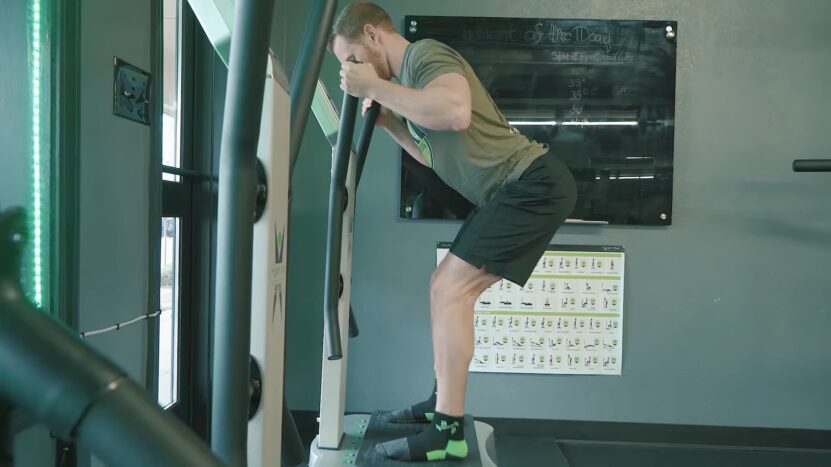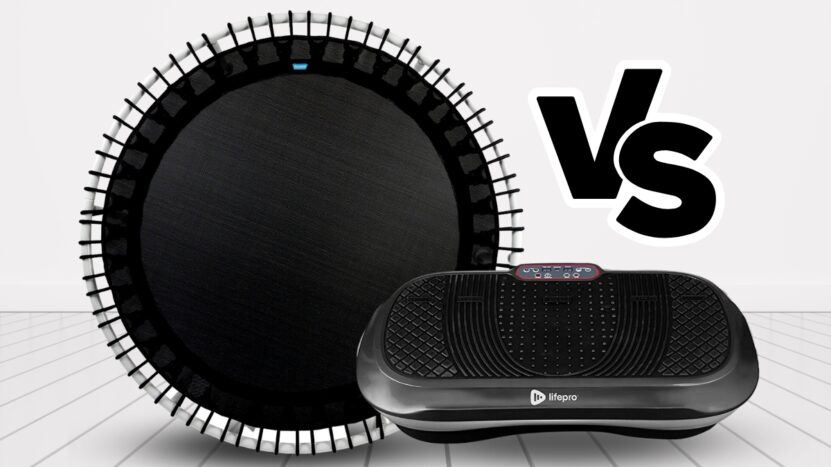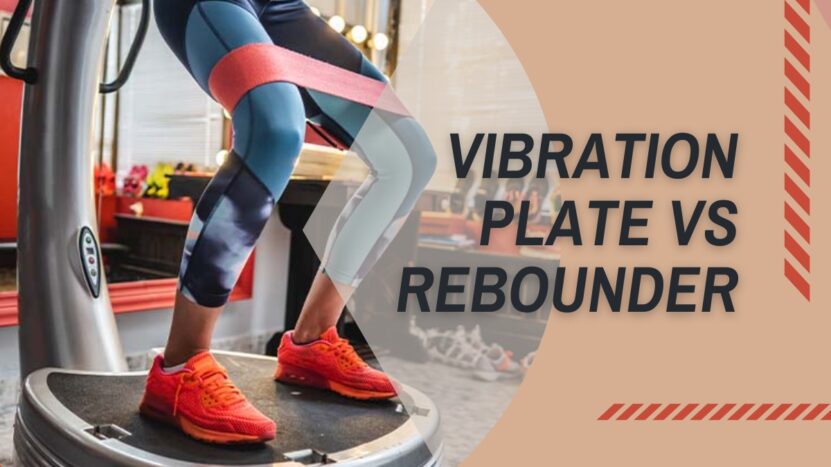In the ever-evolving world of fitness, there are two pieces of equipment that have made their mark in recent years: vibration plates and rebounders. While they may seem like whimsical novelties at first glance, both of these tools pack a potent punch in terms of health benefits. From strengthening muscles to improving cardiovascular health, they offer unique advantages that make them a worthy addition to any workout regimen.
This article aims to delve into the specifics of these two fitness tools and provide a comprehensive comparison to help you decide which one is the best fit for your fitness goals.
Explanation of Vibration Plates
Vibration plates, as their name suggests, function by generating high-speed vibrations. When you stand, sit, or perform exercises on the plate, your body is subjected to these vibrations. The rapid oscillations force your muscles to contract and relax dozens of times per second, essentially giving them a mini-workout. The principle here is known as ‘whole body vibration training’ – a method that aims to stimulate your muscles much more than traditional gravity-based exercises.
The benefits of vibration plates are extensive. They can improve muscle strength, balance, flexibility, and bone density. They also have the potential to aid in weight loss, pain reduction, and increase circulation, which helps with the removal of waste products from the body.
Explanation of Rebounders
On the other hand, a rebounder is a mini trampoline designed for exercise. Rebounding involves bouncing lightly on this trampoline in a manner that impacts the entire body. It is a low-impact aerobic exercise that puts less stress on your joints while still providing an effective cardiovascular workout. The advantages of rebounding are plentiful. It can improve cardiovascular fitness, balance, coordination, and overall muscle tone.
Rebounders are also known to stimulate the lymphatic system, helping your body to detoxify naturally. Furthermore, it has been reported to reduce stress and enhance mood due to its fun and energizing nature.
Comparison
Both vibration plates and rebounders offer unique benefits, but each also has its drawbacks. Vibration plates provide an intense muscle workout in a shorter period, but the vibrations can be uncomfortable for some, particularly those with joint issues or certain medical conditions. They are also typically more expensive and require electricity to function.
Rebounders, meanwhile, offer a fun, low-impact cardiovascular workout that can be enjoyed by all ages. However, they require more physical effort and can be more challenging for those with balance issues. Moreover, their effectiveness depends heavily on the user’s technique.
Health Benefits
Vibration plates offer numerous health benefits. They can strengthen muscles by forcing them to contract and relax rapidly, which can lead to improved muscle tone and strength over time. The vibrations also challenge your balance and flexibility, promoting better posture and reducing the risk of falls. Furthermore, when used in conjunction with a balanced diet, they can support weight loss by increasing your metabolic rate and burning calories.
Rebounders, on the other hand, provide an efficient cardiovascular workout, which can help improve heart health and lung capacity. The bouncing motion stimulates the lymphatic system, aiding in detoxification and boosting the immune system. Additionally, the low-impact nature of rebounding can help reduce stress levels, as it triggers the release of endorphins, the body’s natural ‘feel-good’ hormones.
Which Type of Exercise is Better for Weight Loss?

Both vibration plates and rebounders can contribute to weight loss when combined with a balanced diet. Vibration plates may help increase metabolic rate and burn calories, especially when the exercises performed on them are high-intensity. Rebounders, on the other hand, provide an excellent aerobic workout that can burn a substantial number of calories, depending on the intensity and duration of the workout. In terms of weight loss, both tools can be effective, but the key is consistency and dietary control.
Which is Better for Muscle Strengthening?
When it comes to muscle strengthening, vibration plates may have an edge. The high-speed vibrations cause rapid muscle contractions, effectively working your muscles in a short amount of time. While rebounders can also improve muscle tone, they primarily target leg and core muscles during a basic bounce. That being said, with variations and added movements, a rebounder workout can also provide an all-around strength workout.
Safety Considerations
Safety is paramount when using any fitness equipment. For vibration plates, those with joint problems, heart conditions, or pregnant women should consult a doctor before use. Incorrect usage can also lead to muscle strains or injuries, so learning proper form and technique is critical. Rebounders, while generally safe, can pose a risk for those with balance issues.
It’s essential to maintain control during the bounce, and using a stability bar for support is recommended for beginners or those with balance problems. As with vibration plates, anyone with pre-existing medical conditions should consult a healthcare professional before starting a rebounding regimen.
Cost Comparison
In terms of cost, rebounders typically come out as the more affordable option, with basic models available at a lower price point. However, high-quality rebounders designed for regular use can be comparable in price to vibration plates. Vibration plates tend to be more expensive due to their advanced technology. However, the price can vary widely depending on the model, brand, and features included.
Suitability for Different Fitness Levels
Both vibration plates and rebounders are suitable for a range of fitness levels and goals. Vibration plates are excellent for muscle strengthening, balance improvement, and weight loss, making them ideal for individuals looking to tone up or those with limited mobility. Rebounders, on the other hand, are great for cardiovascular fitness, lymphatic system stimulation, and stress reduction. They’re perfect for people of all ages looking to add fun, low-impact exercise to their routine.
FAQs

Can I use both a vibration plate and a rebounder in my workout routine?
Absolutely! Both tools offer unique benefits and can complement each other well in a balanced workout routine.
Which is better for older adults, a vibration plate or a rebounder?
Both can be suitable for older adults, but it depends on the individual’s health status, balance, and coordination. Vibration plates can be excellent for muscle strengthening and balance improvement, while rebounders offer good low-impact cardiovascular exercise. It’s best to consult with a healthcare provider to determine the most appropriate option.
Which is better for stress relief, a vibration plate or a rebounder?
While both forms of exercise can help with stress relief, rebounding may have an advantage due to its fun and energizing nature. Bouncing on a rebounder releases endorphins, the body’s natural ‘feel-good’ hormones, which can help alleviate stress and improve overall mood.
Are vibration plates and rebounders suitable for beginners?
Yes, both vibration plates and rebounders can be suitable for beginners. However, it’s essential to start slow, learn proper form and technique, and gradually increase the intensity and duration of workouts. For those with balance issues or pre-existing health conditions, consulting a healthcare professional or fitness expert is advised before beginning.
Which is better for improving balance and coordination, a vibration plate or a rebounder?
Both vibration plates and rebounders can help improve balance and coordination. Vibration plates challenge your balance by creating an unstable platform, forcing your body to continually adjust. Rebounders also require balance and coordination to control the bounce. Choosing between the two depends on personal preference, fitness goals, and any health considerations that may impact your decision.
Conclusion
In conclusion, both vibration plates and rebounders have their unique set of benefits, and the choice between the two largely depends on personal preferences, fitness goals, and health considerations. Vibration plates may be more suitable for those looking for muscle strengthening and balance improvements, while rebounders are ideal for those seeking cardiovascular fitness and stress relief.
Ultimately, the best exercise tool is the one that you enjoy and will use consistently. Whether that’s a vibration plate, a rebounder, or a combination of both, investing in your health is always a wise decision. Remember, it’s crucial to consult a healthcare professional or a fitness expert before starting any new fitness regimen to ensure it’s suitable for your health and fitness level. Here’s to a fitter, healthier you!

